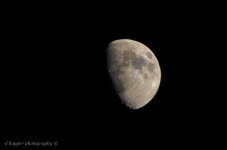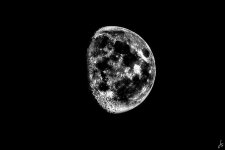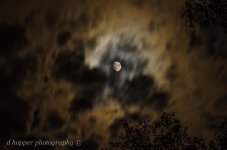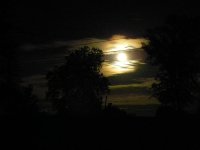You are using an out of date browser. It may not display this or other websites correctly.
You should upgrade or use an alternative browser.
You should upgrade or use an alternative browser.
Post your Moon Shots
- Thread starter Browncoat
- Start date
Very nice. I am sure most people have heard of the "bright sunny day rule" but there is also a "bright moon" rule too. The BSD is 1/ASA @ f/16. The exposure for the moon is 1/ASA @ f/11. Works every time, no metering necessary!
Actually, the full moon is illuminated by our same Sun, so the same Sunny 16 rule is of course applicable. However, the overall albedo of the Moon is around 0.12, so the true surface is actually darker than we like to see it in pictures. So opening one stop does please us more, looks like we think we see it, bright in black sky.
But that one stop is only for a full moon. When the moon is less than full (side lighted at quarter, or back lighted as crescent - instead of frontal lighted at full), we need to open more yet (the angled light does not reflect back to us as directly or efficiently). So yet another stop open for gibbous (2 stops now), and yet another stop for a quarter (which is 3 stops from Sunny 16), and yet another stop for a crescent (or maybe two more stops for a thin crescent). We gotta do what we gotta do.
These are just starting points, of course make it look like you want it to look (you have plenty of time). Spot metering with a long lens sometimes can work (maybe open a stop), but the manual exposure can be controlled better and easier. Metering of mostly black sky will be overwhelmingly overexposed.
But that one stop is only for a full moon. When the moon is less than full (side lighted at quarter, or back lighted as crescent - instead of frontal lighted at full), we need to open more yet (the angled light does not reflect back to us as directly or efficiently). So yet another stop open for gibbous (2 stops now), and yet another stop for a quarter (which is 3 stops from Sunny 16), and yet another stop for a crescent (or maybe two more stops for a thin crescent). We gotta do what we gotta do.
These are just starting points, of course make it look like you want it to look (you have plenty of time). Spot metering with a long lens sometimes can work (maybe open a stop), but the manual exposure can be controlled better and easier. Metering of mostly black sky will be overwhelmingly overexposed.
dh photography
Senior Member
Even more detail and the file is smaller. I assume this was on a tripod!
I'm the crazy guy remember.
I cut out the moon in PS and filled the rest with black. That tends to shrink the file drastically.

That's about the best I can pull out of it for now. I'll try again another day.
Last edited:
dh photography
Senior Member
Don Kuykendall_RIP
RIP :(
Nice night for shooting the moon


CNM Design
New member
Don Kuykendall_RIP
RIP :(
Not bad for a point and shoot.
Yes, good photos









